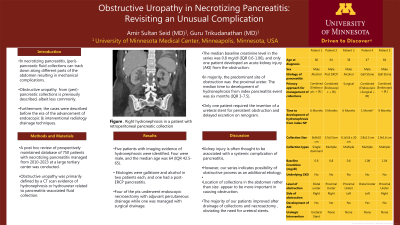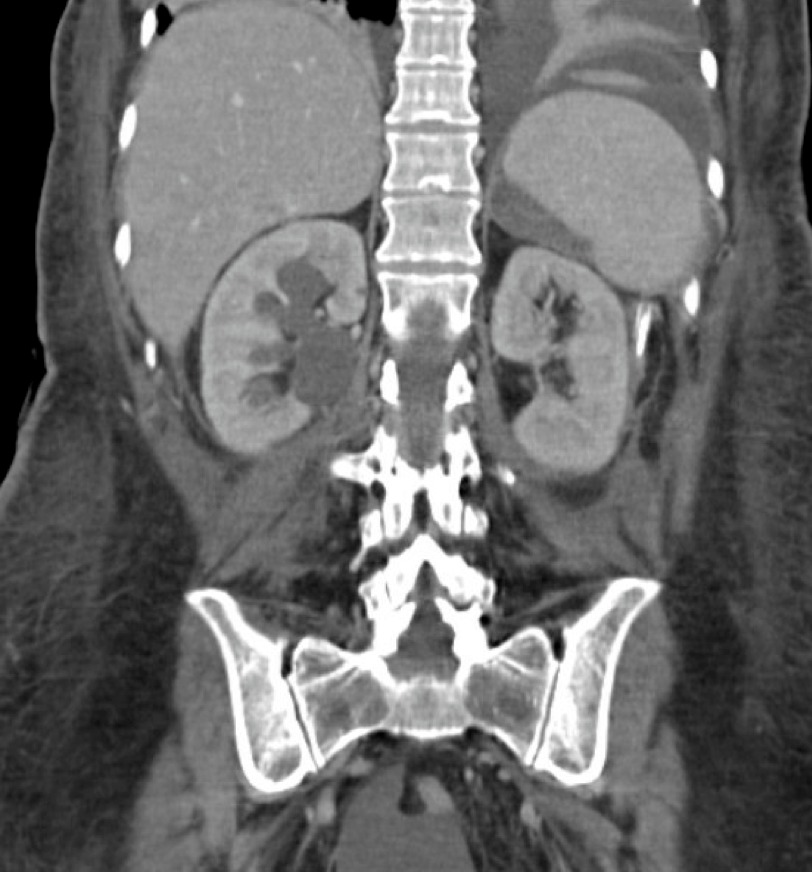Monday Poster Session
Category: Biliary/Pancreas
P1482 - Obstructive Uropathy in Necrotizing Pancreatitis: A Case Series Revisiting an Unusual Complication
Monday, October 23, 2023
10:30 AM - 4:15 PM PT
Location: Exhibit Hall

Has Audio

Amir Sultan Seid, MD
University of Minnesota Medical Center
Minneapolis, MN
Presenting Author(s)
Amir Sultan Seid, MD, Guru Trikudanathan, MD
University of Minnesota Medical Center, Minneapolis, MN
Introduction: In necrotizing pancreatitis, (peri)-pancreatic fluid collections can track down along different parts of the abdomen resulting in mechanical complications. Obstructive uropathy from (peri)-pancreatic collections is previously described, albeit less commonly. Furthermore, the cases were described before the era of the advancement of endoscopic & interventional radiology drainage techniques. We hereby describe a case series of patients with obstructive uropathy in the setting of necrotizing pancreatitis managed in our institution.
Case Description/Methods: A post hoc review of a prospectively maintained database of 750 patients with necrotizing pancreatitis managed from 2010-2023 at a large tertiary center was conducted. Obstructive uropathy was primarily defined by a CT scan evidence of hydronephrosis or hydroureter related to pancreatitis-associated fluid collection. Demographic and clinical characteristics of patients were reviewed.
Five patients with imaging evidence of hydronephrosis were identified. Four were male, and the median age was 64 (IQR 42.5-65). Etiologies were gallstone and alcohol in two patients each, and one had a post-ERCP pancreatitis. Four of the patients underwent endoscopic necrosectomy with adjuvant percutaneous drainage, while one was managed with surgical drainage. Three of the patients had obstruction on the right side. The median baseline creatinine level in the series was 0.8 mg/dl (IQR 0.6-1.06), and only one patient developed an acute kidney injury (AKI) from the obstruction. In the majority, the predominant site of obstruction was the proximal ureter. The median time to development of hydronephrosis from index pancreatitis event was six months (IQR 3-7.5). Only one patient required the insertion of a ureteral stent for persistent obstruction and delayed excretion on renogram. The other patients were managed conservatively with drainage of the collections using endoscopic and percutaneous approaches and supportive measures.
Discussion: Kidney injury is often thought to be associated with a systemic complication of pancreatitis; however, our series indicates the possibility of an obstructive process as an additional etiology. The location of collections in the abdomen rather than size appears to be more important in causing obstruction. The majority of our patients improved after drainage of collections and necrosectomy, obviating the need for ureteral stents.

Disclosures:
Amir Sultan Seid, MD, Guru Trikudanathan, MD. P1482 - Obstructive Uropathy in Necrotizing Pancreatitis: A Case Series Revisiting an Unusual Complication, ACG 2023 Annual Scientific Meeting Abstracts. Vancouver, BC, Canada: American College of Gastroenterology.
University of Minnesota Medical Center, Minneapolis, MN
Introduction: In necrotizing pancreatitis, (peri)-pancreatic fluid collections can track down along different parts of the abdomen resulting in mechanical complications. Obstructive uropathy from (peri)-pancreatic collections is previously described, albeit less commonly. Furthermore, the cases were described before the era of the advancement of endoscopic & interventional radiology drainage techniques. We hereby describe a case series of patients with obstructive uropathy in the setting of necrotizing pancreatitis managed in our institution.
Case Description/Methods: A post hoc review of a prospectively maintained database of 750 patients with necrotizing pancreatitis managed from 2010-2023 at a large tertiary center was conducted. Obstructive uropathy was primarily defined by a CT scan evidence of hydronephrosis or hydroureter related to pancreatitis-associated fluid collection. Demographic and clinical characteristics of patients were reviewed.
Five patients with imaging evidence of hydronephrosis were identified. Four were male, and the median age was 64 (IQR 42.5-65). Etiologies were gallstone and alcohol in two patients each, and one had a post-ERCP pancreatitis. Four of the patients underwent endoscopic necrosectomy with adjuvant percutaneous drainage, while one was managed with surgical drainage. Three of the patients had obstruction on the right side. The median baseline creatinine level in the series was 0.8 mg/dl (IQR 0.6-1.06), and only one patient developed an acute kidney injury (AKI) from the obstruction. In the majority, the predominant site of obstruction was the proximal ureter. The median time to development of hydronephrosis from index pancreatitis event was six months (IQR 3-7.5). Only one patient required the insertion of a ureteral stent for persistent obstruction and delayed excretion on renogram. The other patients were managed conservatively with drainage of the collections using endoscopic and percutaneous approaches and supportive measures.
Discussion: Kidney injury is often thought to be associated with a systemic complication of pancreatitis; however, our series indicates the possibility of an obstructive process as an additional etiology. The location of collections in the abdomen rather than size appears to be more important in causing obstruction. The majority of our patients improved after drainage of collections and necrosectomy, obviating the need for ureteral stents.

Figure: Right sided hydronephrosis in a patient with retroperitoneal pancreatic fluid collection
Disclosures:
Amir Sultan Seid indicated no relevant financial relationships.
Guru Trikudanathan: Boston Scientific Coporation – Consultant.
Amir Sultan Seid, MD, Guru Trikudanathan, MD. P1482 - Obstructive Uropathy in Necrotizing Pancreatitis: A Case Series Revisiting an Unusual Complication, ACG 2023 Annual Scientific Meeting Abstracts. Vancouver, BC, Canada: American College of Gastroenterology.

